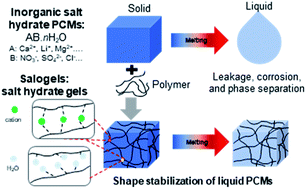Polymers in molten inorganic salt hydrate phase change materials: solubility and gelation†
Abstract
Inorganic salt hydrates are of interest as phase change materials (PCMs) for thermal energy storage because of their unique properties, such as high latent heats of fusion, moderate melting temperatures, high volumetric energy storage densities, and enhanced thermal conductivities compared to their organic counterparts. Because of the low viscosities of molten salt hydrates, the leakage and settling of solids can easily occur during their application. Polymers are promising candidates for preventing these issues. In addition, the non-flammability, non-volatility, and nontoxicity of many molten salt hydrates make them attractive options as “green” solvents for polymers. However, solutions of polymers in molten salt hydrates have rarely been studied and are poorly understood. The highly ionic environments in these materials created due to a scarcity of hydration water for ions leads to strong ionic interactions, with ramifications for polymer solubility and chain expansion. This Perspective article aims to focus on polymer solutions and gels in inorganic salt hydrates by comparing these systems with existing knowledge of polymers in traditional ionic liquids and aqueous salt solutions. To provide insight into the states of ions and water in molten salt hydrates and the degree of hydration of polymers in these solvents, infrared spectroscopy experiments have been performed, and the data are correlated with the temperature-responsive gelation of poly(vinyl alcohol), one candidate material currently used for the shape stabilization of inorganic PCMs. Finally, the thermal properties of inorganic salt hydrates and ionic liquids are compared and strategies for the shape stabilization of inorganic salt hydrates using polymers, through the formation of physical gels, are discussed.

- This article is part of the themed collection: Journal of Materials Chemistry A Recent Review Articles


 Please wait while we load your content...
Please wait while we load your content...
